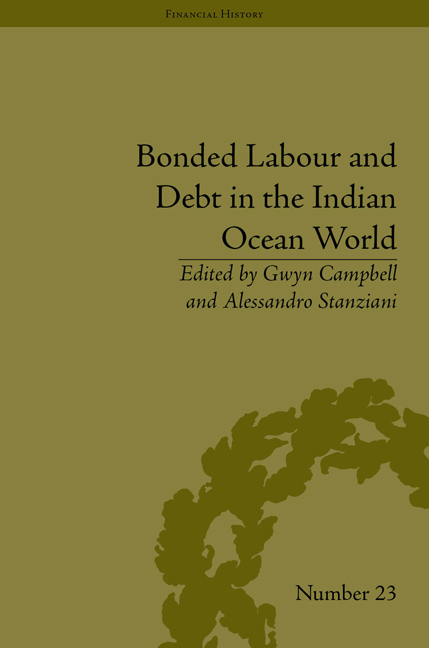Book contents
- Frontmatter
- Contents
- Acknowledgements
- List of Contributors
- Introduction
- 1 Debt and the Coercion of Labour in the Islamic Legal Tradition
- 2 Debt, Pawnship and Slavery in Nineteenth-Century East Africa
- 3 Debt and Slavery in Imperial Madagascar, 1790–1861
- 4 Credit and Debt in the Lives of Freed Slaves at the Cape of Good Hope: The Case of Arnoldus Koevoet, 1697–1735
- 5 Debt, Labour and Bondage: English Servants versus Indentured Immigrants in Mauritius, from the Late Eighteenth to Early Twentieth Century
- 6 Ransom, Escape and Debt Repayment in the Sulu Zone, 1750–1898
- 7 Debt and Slavery among Arabian Gulf Pearl Divers
- 8 The Political Economy of Debt Bondage in Contemporary South India
- 9 The Name of the Slave and the Quality of the Debt: When Slaves Are Not Debtors and Debtors Are Not Slaves in the Family Narrative of a Filipina Comfort Woman
- 10 Two Bonded Labour Emigration Patterns in Mid-Nineteenth-Century Southern China: The Coolie Trade and Emigration to Southeast Asia
- 11 Debt Slaves in Old Korea
- 12 The Debt-Servitude of Prostitutes in Japan during the Edo Period, 1600–1868
- Notes
- Index
11 - Debt Slaves in Old Korea
- Frontmatter
- Contents
- Acknowledgements
- List of Contributors
- Introduction
- 1 Debt and the Coercion of Labour in the Islamic Legal Tradition
- 2 Debt, Pawnship and Slavery in Nineteenth-Century East Africa
- 3 Debt and Slavery in Imperial Madagascar, 1790–1861
- 4 Credit and Debt in the Lives of Freed Slaves at the Cape of Good Hope: The Case of Arnoldus Koevoet, 1697–1735
- 5 Debt, Labour and Bondage: English Servants versus Indentured Immigrants in Mauritius, from the Late Eighteenth to Early Twentieth Century
- 6 Ransom, Escape and Debt Repayment in the Sulu Zone, 1750–1898
- 7 Debt and Slavery among Arabian Gulf Pearl Divers
- 8 The Political Economy of Debt Bondage in Contemporary South India
- 9 The Name of the Slave and the Quality of the Debt: When Slaves Are Not Debtors and Debtors Are Not Slaves in the Family Narrative of a Filipina Comfort Woman
- 10 Two Bonded Labour Emigration Patterns in Mid-Nineteenth-Century Southern China: The Coolie Trade and Emigration to Southeast Asia
- 11 Debt Slaves in Old Korea
- 12 The Debt-Servitude of Prostitutes in Japan during the Edo Period, 1600–1868
- Notes
- Index
Summary
Introduction
The word ‘family’ (from the Latin famulus, ‘domestic slave’) originally referred to a group of slaves belonging to one man, then, by extension, to all persons ruled by one man or his descendants and, finally, to all persons living together in a man's household, including servants, wives, children, parents, grandparents, other close and distant relatives, friends and permanent guests. In patriarchal societies, a man's wife and children are often treated like the slaves of their husband and/or father, thus making the father not a family member, but a master of the household.
In China, traditional customs of wife-lending, wife-mortgaging and wife-selling existed until the Chinese Communist Party came to power in the twentieth century and banned them. However, wife-selling was still occasionally reported in rural areas of the country, and a well-known example comes from Pearl Buck's novel The Good Earth (1931), which depicts the practice of selling children into slavery due to extreme poverty. In Japan, posters advertising the sale of a daughter were occasionally posted on telephone poles during hard times, even up to the modern period.
Such practices were also common in Korea under the Chosun dynasty (1392–1910). Documents pertaining to nobis (slaves) record the case of a man named Jong Il-jae, who found that due to a poor harvest he had no means of fulfilling his filial duty to support his eighty-year-old father.
- Type
- Chapter
- Information
- Bonded Labour and Debt in the Indian Ocean World , pp. 165 - 172Publisher: Pickering & ChattoFirst published in: 2014



